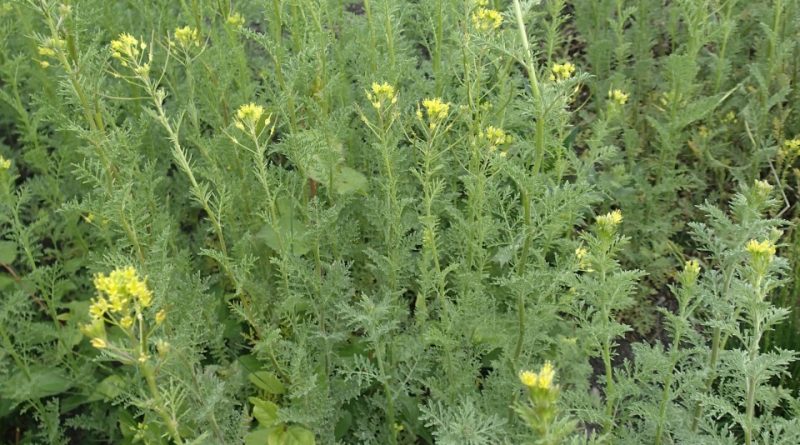Descurainia sophia
Descurainia sophia
The Flixweed, or herb-Sophia or tansy mustard (Descurainia sophia (L.) Webb ex Prantl) is a herbaceous species belonging to the Brassicaceae family.
Systematics –
From the systematic point of view it belongs to the Eukaryota Domain, Kingdom Plantae, Magnoliophyta Division, Magnoliopsida Class, Capparales Order, Brassicaceae Family and therefore to the Descurainia Genus and to the D. sophia Species.
The term is synonymous:
– Sisymbrium sophia L ..
Etymology –
The term Descurainia of the genus was dedicated to François Descourain, French pharmacist and botanist (1658-1740).
The specific epithet sophia comes from the Greek σοφία sophía dexterity, skill, wisdom, wisdom.
Geographic Distribution and Habitat –
The Flixweed is a species with a vast Eurasian distribution, extending from Europe to Japan but also present in North America and with appearances also in North Africa.
In Italy it is present in almost all regions even if it is missing in Calabria and has not been found for a long time in Sicily.
Its habitat is that of uncultivated, ruderal environments, orchards and gardens, along the edges of roads and paths, on soils rich in nitrogen compounds, from sea level to the mountain belt (0 – 2,200 m. S.l.m.).
Description –
Descurainia sophia is an annual or biennial herbaceous plant measuring 20-80 cm, with a tap root.
The epigeal stem is erect, pubescent and branchy at the top.
The leaves are 2-3 pinnatosette of 3-5 cm divided into 0.3-0.5 mm wide laciniae.
The inflorescence is racemic.
The flowers are actinomorphic, tetramer, dialipetal (3-4 mm), with yellow petals of about 2 mm; they have 6 stamens, bi carpellar gynoecium supero syncarpal.
The flowering period is between the months of June-July.
The fruits are 20-25 x 0.7 mm siliques, erect-patent, torulose, carried by about 10 mm peduncles, valves with reticulated veins in addition to the evident median one, very short style.
The seeds are small 0,8-1 mm, not mucilaginous when wet.
Cultivation –
The Flixweed is a spontaneous plant which, judging from its habitat, should succeed in most soils in a fairly sunny position.
It is a nitrophilic plant that can be propagated by sowing in situ.
Customs and Traditions –
The Flixweed is an almost cosmopolitan plant even if with some important gaps that in some areas it can also become a dominant herb.
This plant, especially once, was administered to patients suffering from dysentery and called by the ancient herbalists Sophia Chirurgorum “Wisdom of the surgeons”.
Today its uses have diminished, however in some countries it is still used such as in Iran where the seeds are called khak-e shir (khakshir) and khak-e shir drinks are traditionally preferred as a thirst quencher during hot summer days. Khakshir is also considered a medicinal substance in traditional Iranian medicine, consumed in various combinations with other herbs and substances to achieve effects ranging from antidiuretic to aphrodisiac.
In general, in medicine, it is used as:
– antiasthmatic, antiscorbutic, astringent, bechica, cardiotonic, diuretic, febrifuge, laxative, soothing, vermifuge.
In the food sector it is used as:
– seasoning, using its leaves and seeds.
The seeds of this plant contain 25.5 – 29.9% of proteins, 26.9 – 39.7% of fats and 3.6 – 3.9% of ash on dry matter.
In the past, a poultice from the plant was used to relieve the pain of toothache.
The juice of the plant has been used in the treatment of chronic cough, hoarseness and ulcerated sore throat.
A decoction of the plant has proven excellent in the treatment of asthma.
The flowers and leaves are antiscorbutic and astringent.
The seeds are considered cardiotonic, emollient, diuretic, expectorant, febrifuge, laxative, restorative and tonic.
The seeds have found a special use for sciatica. In addition, a poultice of ground seeds was used on burns and sores.
Among other uses, it should be remembered that a semi-drying oil is obtained from the seeds.
The leaves were preserved with corn to prevent it from spoiling.
In the food field, the young leaves are edible and the ground seeds can be used for the preparation of mustard.
Preparation Method –
The Flixweed can find interesting uses in the food sector. Young leaves and shoots can be cooked and eaten. They have a bitter taste and used as an aromatic herb.
The seeds can be eaten raw or cooked. They have a pungent taste, and mustard substitutes can be used.
The seeds can be ground into powder, mixed with corn flour and used to make bread or as a thickener for soups, etc .; they can also be sprouted and added to salads, etc.
By mixing the ground seeds with water to make a thin batter, you can make a nutritious and refreshing drink.
Guido Bissanti
Sources
– Acta Plantarum – Flora of the Italian Regions.
– Wikipedia, the free encyclopedia.
– Useful Tropical Plants Database.
– Conti F., Abbate G., Alessandrini A., Blasi C. (edited by), 2005. An annotated checklist of the Italian vascular flora, Palombi Editore.
– Pignatti S., 1982. Flora of Italy, Edagricole, Bologna.
– Treben M., 2000. Health from the Lord’s Pharmacy, Advice and experiences with medicinal herbs, Ennsthaler Editore.
Warning: Pharmaceutical applications and alimurgical uses are indicated for informational purposes only, they do not represent in any way a medical prescription; therefore no responsibility is taken for their use for curative, aesthetic or food purposes.


